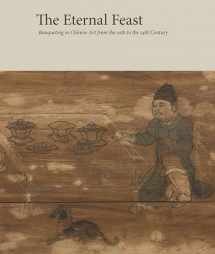
The Eternal Feast: Banqueting in Chinese Art from the 10th to the 14th Century
ISBN-13:
9780300246902
ISBN-10:
0300246900
Edition:
Illustrated
Author:
Zoe S. Kwok
Publication date:
2019
Publisher:
Princeton University Art Museum
Format:
Hardcover
196 pages
Category:
Arts Collections
,
Decorative Arts
,
Decorative Arts & Design
,
Criticism
,
Arts History & Criticism
FREE US shipping
Book details
ISBN-13:
9780300246902
ISBN-10:
0300246900
Edition:
Illustrated
Author:
Zoe S. Kwok
Publication date:
2019
Publisher:
Princeton University Art Museum
Format:
Hardcover
196 pages
Category:
Arts Collections
,
Decorative Arts
,
Decorative Arts & Design
,
Criticism
,
Arts History & Criticism
Summary
The Eternal Feast: Banqueting in Chinese Art from the 10th to the 14th Century (ISBN-13: 9780300246902 and ISBN-10: 0300246900), written by authors
Zoe S. Kwok, was published by Princeton University Art Museum in 2019.
With an overall rating of 3.5 stars, it's a notable title among other
Arts Collections
(Decorative Arts, Decorative Arts & Design, Criticism, Arts History & Criticism) books. You can easily purchase or rent The Eternal Feast: Banqueting in Chinese Art from the 10th to the 14th Century (Hardcover) from BooksRun,
along with many other new and used
Arts Collections
books
and textbooks.
And, if you're looking to sell your copy, our current buyback offer is $0.3.
Description
An overview of Chinese culture, particularly visions of life and the afterlife, told through feast imagery from three historically transformative dynasties
Feasting was an important social and ritual activity in China beginning in the Bronze Age, and cuisine retains a strong cultural significance to this day. This book focuses on feasting in the 10th through 14th centuries, examining Chinese paintings of feasts from the Song (960–1279), Liao (907–1125), and Yuan (1279–1368) dynasties. Feast images, more so than works from any other painting genre, depict scenes from the past, the present, and the afterlife alike. More specifically, as author Zoe S. Kwok explains in the book’s insightful text, they portray a continuum between life and what lies beyond it; this volume is the first to make such a connection. Full-color plates highlight a rare group of paintings as well as complementary ceramic, metal, stone, and textile objects, and the nearly fifty individual catalogue entries touch on diverse topics—not only food and drink but dance, music, costume, burial practices, artistic patronage, and more.
Feasting was an important social and ritual activity in China beginning in the Bronze Age, and cuisine retains a strong cultural significance to this day. This book focuses on feasting in the 10th through 14th centuries, examining Chinese paintings of feasts from the Song (960–1279), Liao (907–1125), and Yuan (1279–1368) dynasties. Feast images, more so than works from any other painting genre, depict scenes from the past, the present, and the afterlife alike. More specifically, as author Zoe S. Kwok explains in the book’s insightful text, they portray a continuum between life and what lies beyond it; this volume is the first to make such a connection. Full-color plates highlight a rare group of paintings as well as complementary ceramic, metal, stone, and textile objects, and the nearly fifty individual catalogue entries touch on diverse topics—not only food and drink but dance, music, costume, burial practices, artistic patronage, and more.


We would LOVE it if you could help us and other readers by reviewing the book
Book review

Congratulations! We have received your book review.
{user}
{createdAt}
by {truncated_author}


